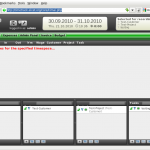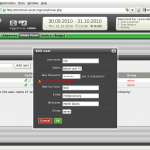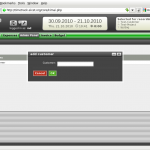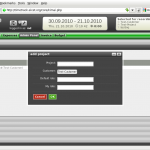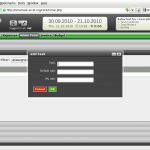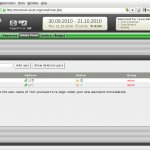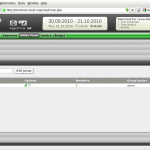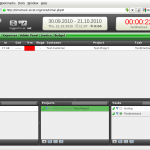 I am a terrible person.
I am a terrible person.
Okay, now that is out of the way, we can get back to business. In this case, literally. Or maybe I should just take that little step back to explain?
The thing is: When I started this website, the intention was to write about literature and history - what I had written and what I was reading.
As it turns out, after I moved to New York and started working for the Danish-American Chamber of Commerce and the law firm Miller Rosenfalck (NY), my focus has sort of drifted to other things. So I have written about software - which I often do - and in this case, I take it a bit further: A piece on business software.
Now, I have actually had a soft spot for this kind of thing for a long time. As is hardly a secret, I am a Free and open source software enthusiast. And ever since I got into working with accounting, I have been interested in the problematic watershed which is crowd-sourcing expertise for specialised applications, and specifically business apps. I doubt there are many who would have the audacity/plain ignorance to claim that Inkscape, Gimp and Blender aren’t impressive. But considering the areas of CAD and accounting are different beasts, and for different reasons. The CAD apps like the Autodesk programs - AutoCAD is the most well-known, I would guess - and SolidWorks - are developed as a highly specialised, closed process, and though one would assume there is a certain overlap between technologists in construction and IT, the community has yet to produce top of the line applications. One might also wonder why these applications have yet to even be ported to Linux and BSDs, considering the fact that they are less resource-demanding than the Windows platforms; but there is simply no expectation of sale. There are applications like the 2D QCAD and the rather impressive, though non-free VariCad, but the industry standard applications are simply not represented. Now, accounting… there are a lot of people who have yet to discover why accounting is sexy. Funny how people in love with the attention to detail that programming requires seem to glaze over when met(/confronted) with accounting tasks. And so, the gap between accounting and software development seems to be an even longer stretch than in the previous example. Again, applications exist, with their own limitations. Most used is probably Gnucash, in interface somewhat similar to Quicken. However, I actually find myself impressed with another system, namely Phreebooks.
Okay, so the above may have reinforced those who think that open source developers should keep a safety distance between coding and the naming of the applications, but this is actually very good.
Phreebooks is not an installable application - in the sense that it is a web application. This is not to say that there is anything preventing you from installing a web server on your desktop machine, but one of the reasons I was looking into this was so I could find something I could host on a web server - the infamous, yet ubiquitous concept of in the cloud - because data centers simply know more about keeping systems alive than I do. Also, I appreciate that a company which is not just a local operation can access the data from anywhere (no, I am not trying to set up an opportunity to do my work from a tropical island, but yes, I appreciate the fact that this would be possible).
The system is a basic double-entry account structure. During installation, you are offered the choice of a set of default accounts, and while this is not necessarily what you need, I found it useful to get an impression of the thoughts behind the setup.
While on the subject on installation: The Installation Guide simply lists PHP5 or higher & MySQL 4 or higher as dependencies - which means you should be able to run it off pretty much any Linux hosting service you can come across. As you go through the installation, you also enter basic information about your company, the fiscal year and the currency you will be using. You will have to create the MySQL database yourself, but after that, it is simply to enter the database credentials, and the installer will pick it up. As you finish the installer, you arrive at a login screen - which will take you to the main overview. Which is not much to look at, at first.
See? Wow. Well, it is simply the beginning. I will get into the categories you see listed there. All these are pull-down menus.
The Customers section allows you to - not just create and manage customers, but this has most of the dealings with the customers in general.
Besides customers, there is a wider CRM - Customer Relationship Management - system built in - PhreeCRM - which works as an extended address book with the contact information on people relevant to your business - to some depth, actually, including also things like Twitter and Facebook IDs and space for your own notes.
This is also the section where you can create quotes for your potential customers - and invoices. Phreebooks are clearly centered around a business selling a physical object; Quotes and invoices are created based on the inventory, and so far, I have yet to determine a way to sell goods which do not work like that - as in the membership we work with at the chamber of commerce or the billable hours we manage at the law firm. I mean, obviously I can start with adding a million of each to the inventory and selling from that pool, but it seems more logical there would be a type of good which would function differently. I am exploring this at the moment. After entering the data for the quote/invoice, Phreebooks can generate a PDF file of the invoice and let you download it - or email it directly from the system. Actually, it can pretty much create a PDF file of any form you might need to keep as a file or print.
The Vendors section once again gives you a clear impression that this is a buy-and-sell company - you can request a quote on every object in your inventory list and send it to the contacts you have created, so it is quite easy to manage these requests. It is even possible to set a preferred vendor for a product, which will be default in your quote request form. This is also the section where you place a Purchase order.
Both of these have a management interface where you can see the list of requested quotes and the purchase orders.
You can probably guess what the Inventory is. An interesting feature is that while you can add products, you can also add ‘assemblies’ - products which are a package of other products. The example is a computer, which is an assembly of hard drive, case, motherboard et cetera.
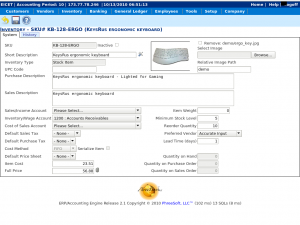 Curiously: While I am not particularly scared off by setup options and freedom choice, the fields available in the Inventory are pretty much open. There is a default selection of fields in the inventory for a product - Product numbers, descriptions, relevant accounts and so forth - but all this is editable! You can set up a field for any metadata you want to associate with the particular item. This is one of those functions which you probably don’t want to touch in the first run, but which will suddenly be a lifesaver at some point, you know? That is the gift of flexibility.
Curiously: While I am not particularly scared off by setup options and freedom choice, the fields available in the Inventory are pretty much open. There is a default selection of fields in the inventory for a product - Product numbers, descriptions, relevant accounts and so forth - but all this is editable! You can set up a field for any metadata you want to associate with the particular item. This is one of those functions which you probably don’t want to touch in the first run, but which will suddenly be a lifesaver at some point, you know? That is the gift of flexibility.
As I said at the beginning of the walkthrough: If you haven’t added items to your inventory, there is nothing you can do; it is all considered a closed circuit - as a true account set should - where values are transferred from one end to the other in the system of debits and credits.
Note, by the way, the History tab in the product view. This offers an overview of how the product is selling.
The Banking section is pretty much just dealing with the cost and income generated from the previous postings. It is for paying the bills, receiving payment, doing refunds - and it allows you to see the cashflow in the cash accounts.
The General Ledger lets you register internal transfers. It is where you access and administer the chart of accounts, and there is a budget function which allows you to target the budget limitations on all accounts.
I was quite happy to see the Employees section, as I was hoping to be able to tie costs and earning into the employees. The section doesn’t exactly do that - it is mostly a question of being able to tag purchases, sales and the like to the person performing them. I did note, however, that it is possible to tie these employees to the users created with access to Phreebooks, which should make the user entering the transaction the default user getting the credit, so to speak, for the transaction.
Okay, so this was the regular user’s side of it. The rest is administration, but no less interesting for that. The first user created has full access to everything as an admin-type account. But it is actually possible when creating a new user to completely define which features this user should have access to - and whether it should be read-only access or full access. The Tools section offers some options which not everyone should have access to - such as being able to delete the company in question - but also functions like setting the designated numbering scheme of invoices, transactions, payments, quote requests et cetera. It is quite elaborate, actually. This is also the section where it is possible to back up the transaction log. The ability to trim it should make Phreebooks more snappy. The Report function makes it possible to generate reports on any type of transaction - from invoicing and cash flow to expected arrival dates of items ordered by vendors. These reports go a long way towards creating an overview of what is actually happening in the operation - on a more approachable level.
An import/export function enables you to use an existing list of customers, vendors, employees etc. - or to make a copy for the sister company with a client/product overlap. This is a clever way of solving that.
Finally, the main tool: It can back up all data from the company accounts. This is obviously very important for safety, but also because it makes it easier to upgrade. I am currently stuck with older data on a CiviCRM installation which I can’t work out how to upgrade around… If one can extract a complete dataset, nuke the installation, install an updated version and import the old data - that can make you happy.
A Setup section will let you define tax rates and currencies - it is possible to work with several currencies, and Phreebooks has the ability to update the currency rates remotely, so you will have the correct exchange rate. Default rates are USD as the primary currency and Euros as secondary. So this section is more centered around the metadata of the transactions.
The last (okay, almost the last) thing I will get into is the Company section. This sets up the default values for the accounts - as in, which account should be default in dealing with which categories, how and when should taxation be applied, what are the basic credit limits - support for several branches, if you are doing accounts for a company with several locations, and how to work with several currencies in the account set.
There is just one more thing, and that is one thing which makes it all a little bit happier to work with. You remember the blank starting page I posted about in the beginning? There is actually an option to create a view profile, so the first you see could be a financial summery, open invoices - or intracompany links or personal notes to keep track of what you need to do.
In conclusion: I believe that Phreebooks could cover the needs of the two operations I am currently working with. The functionality is certainly there, so it would mostly be a question of the user setting up a sensible set of accounts.
I would personally love to see time tracking added to the mix, but this can obviously be covered by other tools like Taskcoach or the web-based Kimai and added as a product sold by the unit. It merely seems practical to me if the employees - who can be tied into Phreebooks user logins - could do billable time tracking as well.
The stylesheets - the color aspects of the design - are not particularly pleasant to look at. While it is definitely functional, it would be nice with a bit of fairly simple graphical overhaul.
The dynamic interface sometimes tries to make some slightly odd guesses as to what you are trying to do. For instance, if you are making an invoice and enter quantity and choose a product from the drop-down product menu, the invoice comment line is automatically filled out - or not, if there is no comment associated with the product - and the cursor moves to the next line. If it is automatically done, why have a specific comment field?
Having said that, I can only conclude it is a very potent package, and I am strongly considering it as a hosted accounting solution.
I am going to do some screenshots of the interface. The link will be arriving shortly.

